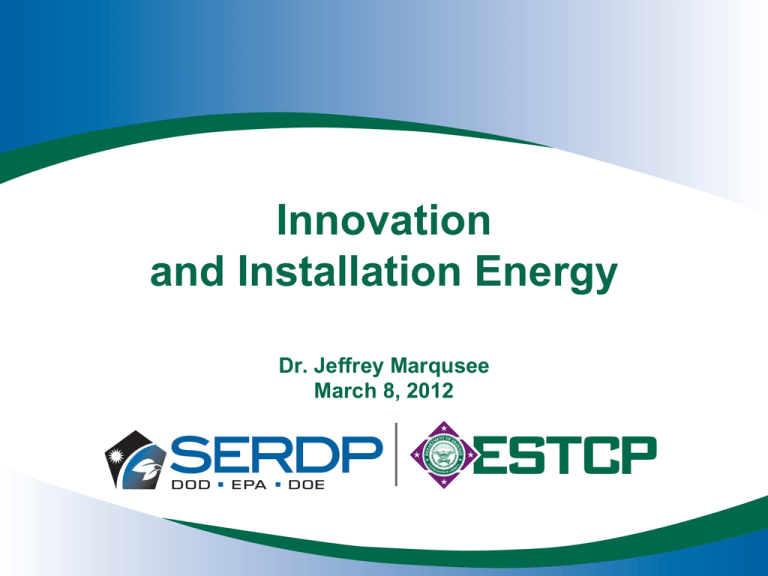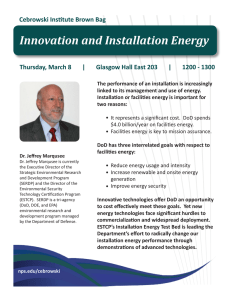Innovation and Installation Energy Dr. Jeffrey Marqusee
advertisement

Innovation and Installation Energy Dr. Jeffrey Marqusee March 8, 2012 DoD’s Environmental & Energy Technology Programs Science and Technology ● DoD, DOE, EPA Partnership t t Advanced technology development to address near-term needs Fundamental research to impact real world environmental management Demonstration/Validation ● ● Demonstrate Innovative CostEffective Environmental and Energy Technologies Promote Implementation t t t Transition technology out of the lab Create Partnerships and Test at DoD Facilities Gain end user and regulator acceptance 2 Environmental Drivers Reduction of Current and Future Liability Pollution Prevention to Control Life Cycle Costs Contamination from Past Practices ● ● ● Groundwater, Soils and Sediments Large UXO Liability Emerging Contaminants ● ● Elimination of Pollutants and Hazardous Materials in Manufacturing Maintenance and Operations Achieve Compliance Through Pollution Prevention 3 Environmental & Energy Drivers Sustainability of Ranges, Facilities, and Operations Maritime Sustainability Threatened and Endangered Species Toxic Air Emissions and Dust Noise UXO & Munitions Constituents Installation Energy Climate Change 4 Program Areas Weapons Systems & Platforms Environmental Restoration Energy & Water Resource Conservation & Climate Change Munitions Response 5 Drivers for DoD Environmental & Energy RDT&E ● Needs t t t Unique military requirements Mission critical Regulatory § EPA, States, DOI, EO …. t t ● Economics Policy Opportunities t DoD’s Unique position § Natural and built infrastructure t t DoD’s unique culture DoD’s market size DoD Energy Costs DoD Energy Costs FY11: $19.4B (FY10: $15.2B) Installations * $4.12B in facilities energy costs include non-tactical vehicle fuel $3.85B – facilities energy $0.27B – non-tactical vehicle fuel 7 Why Facilities Energy Matters ● Significant Cost FY11: $4.1 billion t Cost likely to increase (reduced presence in Iraq and Afghanistan) Army CO2 Emissions Today t ● Facilities 50% Environmental Impact t ● Generators 17% Contributes a disproportion share (~ 40%) of GHGs Mission Assurance/Energy Security t DoD’s reliance on a fragile commercial electricity grid places continuity of critical missions at serious and growing risk Combat Aircraft 15% Tactical Vehicles 16% Non-­‐Tactical Vehicles, 2% Army CO2 Emissions Future? Facilities 77% Non-­‐Tactical Vehicles 5% Generators 2% Combat Aircraft 10% Tactical Vehicles 5% 4 Key Energy Goals • Legislation and Executive Orders – EPAct 2005, EISA 2007, NDAA – EO 13423, EO 13514 • Key Targets – Facility Energy Efficiency § Reduce facilities energy intensity by 30% by 2015 and 37.5% by 2020 (2003 baseline) – Renewable Energy § Produce or procure 25% of facilities energy from renewable sources by 2025 – Water § Reduce potable water intensity by 26% from a 2007 baseline by 2020 – Non-Tactical Fleet Petroleum Fuel Consumption Reduction § Reduce non-tactical fleet fuel consumption by 30% by 2020 (2005 baseline) 9 DoD Progress Energy Intensity Reduction: 13.3% (FY11 Goal: 18%) Water Intensity Reduction: 10.7% (FY11 Goal: 8%) 10 USC 2911e RE: 8.5% (FY11 Goal: 11%) NTV Petroleum Reduction: 11.8% (FY11 Goal: 12%)10 Facilities Energy Strategy Reduce Demand Expand Supply Enhance Security Advance New Technology 5 ESTCP Installation Energy Test Bed ● Use DoD Facilities As Test Bed For Innovative Energy Technologies t t t t ● Validate performance, cost, and environmental impacts Transfer lessons learned, design and procurement information across all Services and installations Directly reach out to private sector for innovations Directly leverage DOE investments Develop, Test & Evaluate For All DoD Facilities t t t Energy Conservation & Efficiency Renewable and Distributed Energy Generation Control & Management of Energy Resources & Loads Reduce Energy Costs - Improve Energy Security 18 Why The Test Bed Is Needed ● Emerging technologies hold the promise of dramatic improvements in installation energy performance but face major impediments to commercialization and deployment ("Valley of Death") t Highly cost-sensitive market inhibits introduction of new technology § t “Split incentives” or “Principal agent” problem § t return on the capital investment is often in terms of avoided future costs and integrated performance Lack of operational testing inhibits commercialization and deters potential adopters § t significantly more risk and highly fragmented market Lack of information results in high transactional costs and an inability to properly project future savings § t entity that bears the up-front capital costs is not the same as the one that reaps the savings No incentive for first use § t Energy is a cost of doing business and thus rarely the prime mission of an enterprise – technologies do not usually provide the end customer with a new capability unlike IT or biotech – costs are sensitive to the operational efficiency ,maintenance, and the lifetime of the component conditions such as building operations, variable loads, human interactions A&E firms face liabilities but do not share in savings § prefer reliability over innovation 19 DoD Built Infrastructure ● 539,000 Facilities (buildings and structures) t 307,295 buildings § 2.2 billion square feet ● Comparisons t GSA: 1,500 government buildings DoD Building Stock Community Facilities 11% Utility & Ground Improvements 1% Troop Housing & Mess Facilities 12% Operation & Training 10% Maintenance & Production 14% § 176 million square feet t Wal-Mart US: 4,200 buildings § 687 million square feet ● RDT&E 3% Family Housing 20% Supply 15% 160,000 Fleet Vehicles Administrative 10% Hospital & Medical 3% 3 DoD Built Infrastructure Investments t Military construction § ~ $12 B t Sustainment § ~ $8 B t Recapitalization § ~ $9 B t t Distribution of Building Size (sq. ft) ~$1B of this is energy conservation Plus ~ $1B of private financing for energy conservation 15 Installation Energy Roadmap Smart Secure Installation Energy Management • Micro-grids • Energy Storage • Ancillary Service Markets Efficient Integrated Buildings • Design, Retrofit, Operate • Enterprise Optimized Investment • Advanced Components • Intelligent Building Management On-Site Energy Generation • Cost Effective Renewables • Waste to Energy • Geothermal • Building Integrated Opportunities 21 Installation Energy Security ● DoD Facilities Are a Large Consumer of Electricity t t t t ~ 30B KWhr electricity in 2010 worldwide US installations peak power range from ~10MW to over 100MW DoD installations are in most electricity markets DoD Installations often do not look like commercial facilities § Power profiles and security concerns ● Changing Market Offer DoD Installations Opportunities t ● New revenue streams DoD Drivers t t Economics Energy security Smart Micro-Grids 17 Military Installations and Energy Markets Regulated Market Deregulated Deregulation on hold Military installation Energy: http://www.eia.gov/cneaf/electricity/page/restructuring/restructure_elect.html Military installations: http://tigerline.census.gov/cgi-bin/shapefiles2009/national-files 18 California Military Installations and Electricity Markets Balancing Authorities (10) Utility Companies (57) MCAGCC Twentynine Palms Ft Hunter Liggett Vandenberg AFB Military installation MCAS Miramar CA information: http://www.energy.ca.gov/maps/ 19 Demand Data - Examples 14 13 Jan Feb March April May June July Aug Sept MIT Lincoln Laboratory Oct Nov Dec Mean = 9.0 MW Peak =13.5 MW 12 11 MIT LL Offices and laboratories, low weekend usage. Significant monthly variations due to weather 10 9 8 60 50 Jan Feb March April May June July Aug Sept Oct Nov Dec Navy Base San Diego Living quarters as well as working, less daily variation 40 30 20 10 NBSD Mean = 36.4 MW Peak = 58.8 MW Presence of ships affects energy demand Military Installations Often Do Not Look Like Commercial Facilities 20 Smart Secure Installation Energy Management Smart Microgrid at 29 Palms Lockheed Martin Microgrid at Ft. Bliss Sodium-Metal-Halide Battery Energy Storage System at 29 Palms Zinc Bromide Flow Batter at MCAS Miramar 25 Energy Efficient Integrated Buildings optimized investments - advanced components - intelligent building management 22 Efficient Integrated Buildings Electrochromatic Windows Continuous Building Commissioning Systems Approach to High Performance Buildings Drive-By Thermal Imaging Systems Approach to High Performance Buildings 22 On-Site Generation BIPV Roofs Low-BTU Landfill Gas Microturbine Grid Parity Solar Power Solar Air Heated Roofs 23 ESTCP Demonstrations ● Technologies are sought that can significantly benefit from a demonstration on a DoD installation ● Priority is given to technologies for which a demonstration on a DoD facility is required to: t t assess the cost and performance of the technology provide information that will accelerate commercialization and broader adoption 25 ESTCP FY 2013 Solicitation 1. Smart Secure Integrated Installation Energy Management 2. Cost Effective On-Site Distributed Generation 3. Advanced Component Technologies to Improve Building Energy Efficiency 4. Advanced Building Energy Management and Control 5. Tools and Processes for Decision-making Associated with Energy Use and Management 6. Advanced Water Management and Controls for DoD Buildings http://serdp-estcp.org/Funding-Opportunities/ESTCP-Solicitations/Installation-Energy-Solicitation 26 Web site www.serdp-estcp.org 27 Installation Energy Topics FY13 1. Smart Secure Integrated Installation Energy Management t Innovative approaches to improve the security of an installation’s overall energy management, decrease costs, and provide new revenue streams t Technologies that enable the implementation and management of smart micro-grids on Department of Defense (DoD) installations to meet DoD energy security goals t Micro-grid demonstrations should involve the integration of new or existing combinations of controls, generation sources and storage among clusters of buildings t Demonstrations are also of interest which enable participation in the advanced demand response and ancillary services markets and the integration of innovative electric vehicle infrastructure solutions. 28 Installation Energy Topics FY13 2. Cost Effective On-Site Distributed Generation t Innovative technologies to increase distributed and renewable energy generation on DoD installations to meet DoD energy goals t Demonstrated technologies must show a levelized cost of electricity that reflects grid parity for the proposed application or a clear pathway to grid parity when mature t Renewable technologies of interest include, but are not restricted to: § Solar & Geothermal § Waste-to-Energy & Biomass – biomass and waste-to-energy systems should be economically efficient without import of off-installation resources t Renewable technologies involving hydroelectric, offshore wind or liquid biofuels for transportation will not be considered under this solicitation. 29 Installation Energy Topics FY13 3. Advanced Component Technologies to Improve Building Energy Efficiency t Cost effective component technologies to increase energy efficiency in DoD buildings to meet DoD energy goals § innovative technologies appropriate for building retrofits t Technologies of interest include, but are not restricted to: § Heating § Ventilation and air conditioning § Building envelope technologies § Lighting and waste heat recovery (for heating or cooling) t Integrated demonstrations of combinations of technologies are also of interest, including building integrated renewable energy systems 30 Installation Energy Topics FY13 4. Advanced Building Energy Management and Control t Innovative cost-effective technologies or combinations of technologies to meet energy goals by increasing the performance of DoD buildings § Desired energy use reductions occur through increased efficiency in commissioning, diagnostics, and operations. t Technologies of interest may also improve: § Advanced metering or sub-metering § Increase the quality and reliability of building performance data § Ensure compliance with DoD communications and information assurance requirements 31 Installation Energy Topics FY13 5. Tools and Processes for Decision-making Associated with Energy Use and Management t Innovative technologies to provide individual energy users, building managers, facility managers, regional managers and/or DoD portfolio and enterprise managers the right amount of information at the right time to make appropriate decisions related to energy usage and investments t Tools to provide energy managers, particularly at military installations, with the ability to evaluate the business case for energy infrastructure retrofits and new investments, exploit advanced metering systems, measure and validate energy performance and visualize trends t Holistic management tools that address energy, waste and water on military installations are also appropriate for demonstration 32 Installation Energy and Water Topic FY13 6. Advanced Water Management and Controls for DoD Buildings t t Water management technologies and processes that will reduce water loss and increase the efficient usage of available water Technologies that improve water usage in buildings or clusters of buildings by addressing: § § § § § t Water conservation Leak detection and repair Greywater reuse Rainwater harvesting Energy associated with water management. Tools and processes that enable managers to identify, implement and measure the impact of water savings and reuse technologies and practices 33




